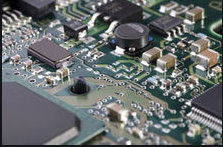PCBA processability review.
1. Selection of components. Solderability. Heat resistance. Coplanarity.
In PCBA design, chip components should be used as much as possible to use chip components, and strive to make the duty cycle of chip components on the PCBA reach more than 95%.
2. Selection of PCB substrate. Solderability. Heat resistance. Flatness.
3. PCB design rules.
Conductive pattern layout and wiring.
Design requirements for pad design and component spacing.
The size of the printed wire, the pad and the metallized hole (insertion hole, relay hole) and the safety distance between them.
Electromagnetic compatibility.
Heat conduction and heat dissipation.
PCB surface coating.
Solder mask graphics.
Machinability.
Detectability.
4. Forbidden and restricted design and process requirements.
5. Component installation.
6. Requirements for special components.
7. Component reinforcement and three-proof requirements.
PCB and PCBA pattern design process review
1. PCB.

The same pad must not be shared between surface mount components, between surface mount components and through-hole insertion components, and between surface mount components and leads, in accordance with GJB 3243-1998, SJ/T 10670- 1995 and IPC-SM-7351B-2010 requirements.
The printed circuit board design documents are exactly the same as the actual product in terms of name, drawing number, tag number, model, specification, etc.: The diameter of the metallized hole should be greater than the lead diameter of the component or the outer diameter of a wire core 0. 2~0.3mm, the relationship between the lead diameter and the diameter of the metallized hole and the diameter of the pad is shown in the table below. Or install components and chip components on the tin-plated layer for grounding and heat dissipation. The non-installation solder area on the surface of the printed circuit board must have a solder mask, and there must be no fusible metal under the solder mask.
Solder mask coating requirements.
Requirements for surface coating of printed wires and pads.
When the printed circuit board needs to pass a large current, the width of the printed circuit can be widened by using an external wire or using a thicker copper and platinum substrate.
2. PCBA.
The external dimensions and installation and fixing methods of the printed circuit board should match the reserved positions and fixing methods of the structural parts.
Components, especially high-density integrated circuit layout (density, installation space and adjacent spacing) and reinforcement measures.
Heat conduction and heat dissipation measures and reinforcement measures and their installation space.
The rationality, stability and safety distance of component installation.
PCBA anti-warping and anti-mechanical environment reinforcement and anti-environmental erosion protection.
Installation requirements for terminal and wire.
Maintainability and implementability.
3. Technical requirements for printed circuit board assembly drawings.
Assembly and welding are carried out according to QJ165B.
The installation height of the components (refers to the distance between the top of the component and the surface of the PCB) and the special forming requirements of the components.
Components that are not installed, short-circuited, or unconnected.
Requirements for components to be equipped with sockets.
Indicate the code, name and model of anti-static components.
Components with a mass greater than 14g should be marked with reinforcement bonding requirements.
Fixing points and methods of Ning jumper wiring. High-temperature components that are likely to cause short circuits (such as metal film resistors and wire wound resistors above 1W) shall not be mounted on the board.
Transistor pins are not allowed to be installed crosswise.
Three-proof requirements for printed circuit boards.
4. Except for high-frequency microwave circuits, no overlapping wires are allowed on the printed circuit board, and it is not allowed to use overlapping installation methods for plug-in components, that is, discrete R, C, L, IC, G and other components are installed by overlapping on the printed circuit board pads, printed wires and component leads.
5. Jumper wires on the printed circuit board.
Generally, no jumper wires are needed on the printed circuit board. If it must be used, the number of jumper wires allowed should not exceed two in principle: if the number of jumper wires exceeds two due to the discreteness of components, it should be approved by the project chief engineer.
Jumper wires should be as short as possible.
The wiring shall not hinder the replacement of components or other jumper wires.
The jumper should have a fixed point every 25mm at the longest.
Jumper wires should be regarded as axial lead components and should meet the detailed requirements for the installation of axial lead components.
Jumper wires should not pass through the upper or lower parts of other components (including jumper wires).
When the length of the jumper wire is less than 12.5mm, and its routing does not pass through the conductive area and meets the electrical spacing requirements, a bare silver-plated copper wire can be used.
Jumper wires in "Repair and Modification of Printed Circuit Board Assemblies".
A. At most two jumper wires are allowed to be connected to any vacant component pad.
B. The jumper wires should be routed along the X-Y axis, and there should be no twists or cracks on the wires.
C. The jumper wires should be as short as possible, and no wires should be routed above and below the components.
D. The length of the jumper wire contact shall not be less than 1/2 of the length or height of the metalized terminal of the component (see SJ 20632-1997 Appendix A).
E. If multiple jumper wires are welded to one end, the uninsulated parts of the wires can be twisted together and then welded.
F. The jumper should be firmly fixed in the place where the positioning is required with adhesive, and the adhesive must be fused with the conformal coating.
Each metallized hole only allows one component lead or one wire to be welded.
Surface mount components must match the pads on the printed circuit board and meet the requirements of GJB 3243-1998, SJ/T 10670-1995 and IPC-SM-7351B-2010.
The printed circuit board should be nickel-plated gold process or hot air leveling process (SMOBC), and indicate on the assembly drawing.